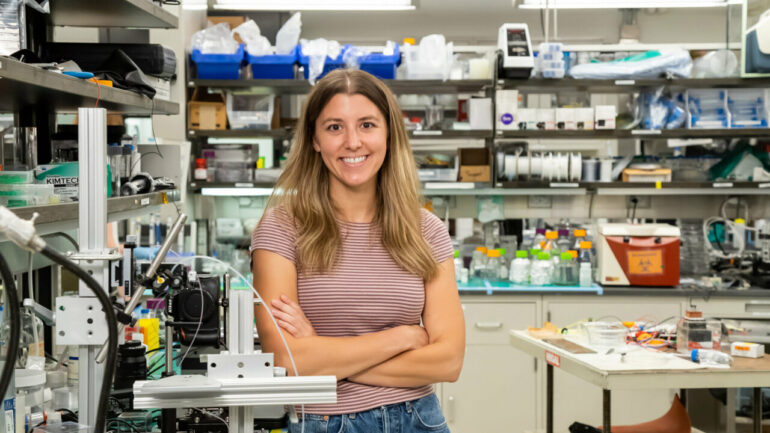It’s a little-known fact that tiny particles like blood cells drift sideways when moving past a rough surface, but this quirk has drawn much attention from researchers solving industrial problems.
Why? Because if engineers can unlock the rules behind this tiny movement, industries can use them to isolate biological samples, detect and diagnose disease, or sort synthetic particles.
Now Danielle Chase, a fifth-year graduate student at Princeton Engineering, and Christina Kurzthaler are co-first authors of a paper in the Proceedings of the National Academy of Sciences that offers the first general model describing the interaction of patterned surfaces and sedimenting particles.
Chase, advised by Professor Howard Stone, worked closely with Kurzthaler, a former postdoctoral fellow in Stone’s lab and now a research group leader at the Max Planck Institute for the Physics of Complex Systems. Together they pinned down the system’s “rules” so researchers can predict how their designs will work instead of using trial-and-error.
“It was satisfying to finally understand the mechanism causing the helical trajectories and overall drift and to have a hydrodynamic model that described our experimental observations so that we could predict what would happen if, say, someone tried to separate two objects of different sizes,” Chase said.
Beyond the achievement itself, Chase said she enjoyed the sense of open-ended discovery and collaboration. Chase designed and built the physical experiments while Kurzthaler developed the theoretical model describing the behavior.
Chase said that Stone, the Donald R. Dixon ’69 and Elizabeth W. Dixon Professor of Mechanical and Aerospace Engineering, never dictated the exact direction of the research, but was very supportive of all aspects of the project.
Instead, the questions Chase and Kurzthaler pursued emerged from their shared curiosity about what they were observing, including the particles’ surprising helical motion. “Our observations led to more questions,” Chase said. “That helped us find more interesting aspects of the system, like how the shape of the patterns impacts the particle motion.”
While previous researchers used experimental setups to observe particles flowing through thin channels, Chase and Kurzthaler got rid of the walls except for one patterned surface. This allowed them to limit the variables and focus just on the particle and the surface.
“I think what we learned in the end really benefited from us both having different approaches to the problem,” Chase said. “Having a theory helps to design good experiments and having measurements helps to confirm the theory.”
Now close to completing her doctoral work, Chase is excited to continue research in fluid dynamics. “The more you learn, the more questions you find,” she remarked.
More information:
Danielle L. Chase et al, Hydrodynamically induced helical particle drift due to patterned surfaces, Proceedings of the National Academy of Sciences (2022). DOI: 10.1073/pnas.2202082119
Provided by
Princeton University
Citation:
A fluid interaction inspires a breakthrough in fluid dynamics (2022, August 18)
